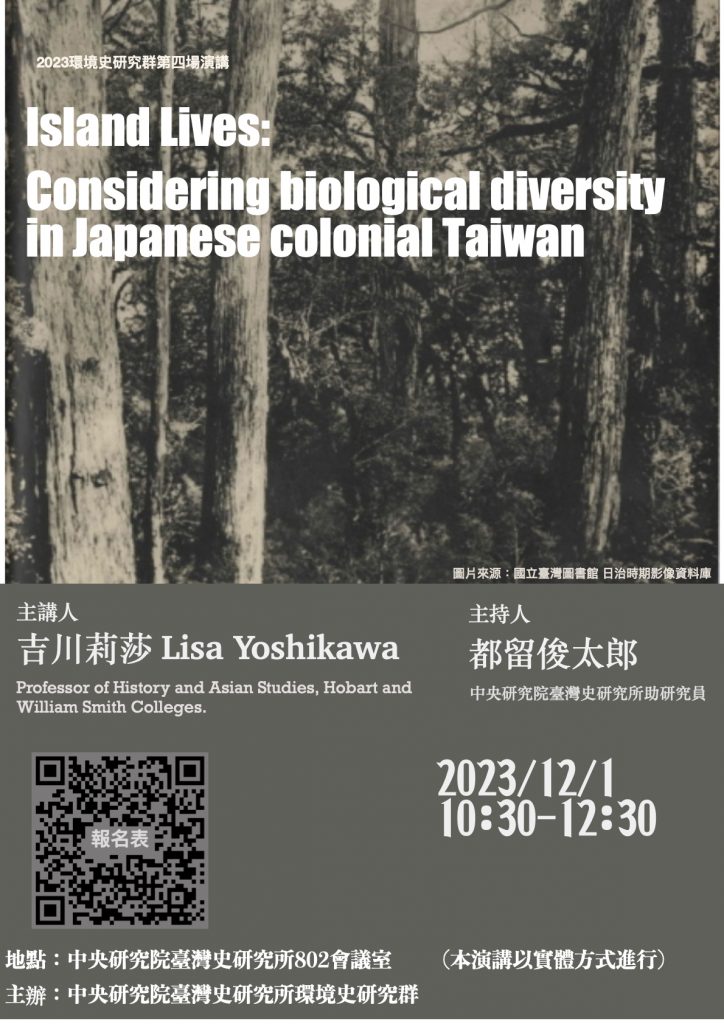講題:Island Lives: Considering biological diversity in Japanese colonial Taiwan
主講人:吉川莉莎 (Professor of History and Asian Studies, Hobart and William Smith Colleges)
主持人:都留俊太郎(中央研究院臺灣史研究所助研究員)
日期:2023年12月1日(五)
時間:10:30–12:30(GMT+8)(10:00開放入場)
地點:中央研究院臺灣史研究所802會議室
地址:11529 臺北市南港區研究院路二段128號 (人文社會科學館北棟八樓)
進行方式:實體,本次講座不提供線上直播
主辦單位:中央研究院臺灣史研究所環境史研究群
報名連結:https://forms.gle/dpCR7bkxA9FvAFxd6
【摘要】
自19世紀中葉起至1942年的巔峰期,日本帝國領土所涵蓋之經緯度大致擴增了六倍。這片廣袤的空間包含陸地和水域,與當代其他帝國相比,其相對毗連的領土與龐大的島嶼結構是獨一無二的。由於日本帝國緯度範圍橫跨亞北極到熱帶,其植物和動物物種的多樣性所帶來的資源潛力十分引人注目,因此各領域的自然史學家和生物學家,時常是此類榨取式帝國主義的先驅,以識別並為大都市獲取資源,特別是在人口迅速增長和工業化的世紀之交。在新獲得的領土上,動物學者很快就開始更全面地研究動物群,包括其多樣性和分布,無論其是否對人類有直接經濟效用。在帝國擴張之時,阿爾弗雷德·羅素·華萊士(Alfred Russel Wallace)的《島嶼生命》雜誌的發行,以及有益於該期研究主題 — — 動物地理學 — — 的地理學規劃,使該領域在日本帝國內蓬勃發展。1928年,日本科學家成為世界上第一批建立生物地理學會的科學家之一,僅次於法國,該機構在隔年即開始出版相關刊物。《島嶼生命》這本以英文為主的期刊,一直持續運作至1944年,在日本帝國時期成為科學家在國際上展示其最新動物地理學研究的舞台,作為當時印太地區科學競爭的一部分。在該刊發行的前十年半中,最受歡迎的研究地點包括千島群島、大都市和臺灣。
環境、科學與政治因素使得臺灣得以位處動物地理學研究的中心地位。臺灣的(亞)熱帶特性提供了動物物種多樣性,而時常抵銷此一優勢的島嶼性卻能反過來突顯定居動物群的某些特性,這些特性使得島嶼成為歷史上如達爾文、胡克和華萊士等人喜愛的動物地理學研究地點,近期則是麥克阿瑟/威爾遜。這種重要性並沒有被日本帝國的科學家所忽視,對他們而言,南北軸上的島嶼領土,包括臺灣,明顯比東西軸上的大陸殖民地更為重要。日本帝國早期所取得的臺灣,除了具有合法殖民地的地位,也具備豐富資源,刺激日本帝國在臺灣建立基礎設施,包含重要的調查據點與研究機構。實際上,在1932年從全帝國29個城市中選出的日本生物地理學會會,臺北成為會員人數第二多的城市,僅次於東京。生物地理學是當今環境保護中至關重要的一門學科。本演講旨在深入探討臺灣動物及動物地理學研究者,在20世紀上半葉發展此一重要領域中的角色。
【備註】
1.現場與會請於11/27(一)前填寫表單如有任何問題,歡迎聯絡助理李孟霖先生asithteh@gmail.com。
2.本講座以英文方式進行,不提供線上直播,現場名額限50人。
3.本講座為本院環境教育項目之一,全程參加者可得2小時環境教育時數。領取方式說明:(1)現場與會者於活動現場領取。(2)非所內人員請至原服務單位完成登記手續。
4.現場活動將提供午膳,請於報名表中選擇葷食或素食,亦可選擇不用餐。
Topic: Island Lives: Considering biological diversity in Japanese colonial Taiwan
Speaker: Lisa Yoshikawa (Professor of History and Asian Studies, Hobart and William Smith Colleges)
Moderator: Tsuru Shuntaro ( Assistant Research Fellow in the Institute of Taiwan History, Academia Sinica) Date: Dec. 1th, 2023
Time: 10:30–12:30(GMT+8)
Venue: Meeting Room 802, Institute of Taiwan History, Academia Sinica Address: 8F, Social Science North Building, №128, Sec. 2, Academia Rd., Nangang District, Taipei City
Organizer: Environmental Research Group, Institute of Taiwan History, Academia Sinica
Abstract
From the mid-nineteenth century to its height in 1942, the Japanese empire approximately sextupled both latitudinally and longitudinally. This enormous space contained both terrestrial and aquatic regions and was unique amongst contemporary empires in its relative contiguity and its large insular composition. Its latitudinal span from the subarctic to the tropics was of particular interest for resource potentials due to the variety in plant and animal species it offered. Natural historians and biologists in various fields hence were often pioneers in this extractive imperialism to identify and secure resources for the metropole, particularly with the rapid population growth and industrialization starting at the turn of the century. In the newly acquired territories, zoologists soon began to study more generally the animal population, including their diversity and their distribution, regardless of their direct economic utility to humans. The timing of the empire’s expansion that coincided with the publication of Alfred Russel Wallace’s Island Life and its geographical layout that was conducive to the study of the volume’s topic, zoogeography, led to the blossoming of the field in Imperial Japan. In 1928, Japanese scientists became one of the first in the world to establish a biogeographical society, second only to the French, with its organ starting publication in the following year. This predominantly English language journal that continued until 1944 under Imperial Japan became a stage on which scientists showcased their latest zoogeographical research internationally as part of the contemporary Indo-Pacific science competition. Of the most popular target locations for research in its first decade and half of existence were the Kuriles, metropole, and Taiwan.
Taiwan’s centrality in zoogeographical research resulted from environmental, scientific, and political reasons. Its (sub)tropicality offered animal species diversity and its insularity that often countered this advantage in turn accentuated certain features about the resident population that had made islands a historically favorite zoogeographical research site, for the likes of Darwin, Hooker, and Wallace, and later MacArthur/Wilson. Such significance was not lost on Imperial Japanese scientists to whom island territories on the N-S axis, including Taiwan, was clearly more important than continental colonies on the E-W axis. The empire’s early acquisition of Taiwan, in addition to its legal colonial status and attraction as a resource-rich domain provided incentives to establish infrastructures including research institutions that became important bases for investigations. In fact, of the 29 empire-wide cities from which the Japan Biogeographical Society members hailed in 1932, Taipei had the second largest number of members following Tokyo. Biogeography is a discipline crucial to environmental conservation today. This talk seeks to provide insights into the role of Taiwanese animals and and their scientists in the development of this important field during the first half of the twentieth century.
Attention:
1.Please register before Nov. 27th. Feel free to contact Mr. Lee if there is any question. E-mail: asithteh@gmail.com.
2.The lecture will be given in English. The meeting room holds 50 participants, and there is no online streaming for this lecture.
3. Participants can apply for a two-hours “Certificate for Environmental Education.” The certificate will be issued after the lecture in a form of a hard copy
4.Lunch boxes are provided for all the participants.
